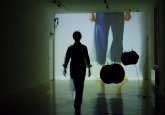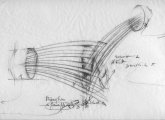Windportraits | 2000-02
sound and video installation
The room installation
The installation "Windportraits" (wind portraits) explores the possibilities of making invisible occurrences such as the displacement of air by motion ascertainable and conceivable. Everything that moves displaces air and every human being has a personal profile and a very individual way of moving. From this I conclude that every human must also have their own pattern of air displacement which I want to show. My intention is not to produce physically precise measurements but to demonstrate the displacement process by visual and acoustic means. In this context the notion of displacement process has also a social connotation.
The central element is a wind machine consisting of a sculpture pair of two big barrel-shaped ventilators hanging from the ceiling. A video is projected on the wall showing the legs of a person who moves in a circle before jumping out of the picture.
Here the sculpture pair and the two bass loudspeakers mounted behind it are the acoustic sources. The first sound to be heard is a rhythmic sequence of word fragments: a slightly swelling and ebbing soft sound tapestry. The second sound is produced by a Japanese woman who recites a haiku dealing with the topics of "wind" und "transience/ death".
The invisible portrait
In my video and sound works I use simple gestures and language codes as a medium to express, transfer and change complex communication structures. The installation "Windportraits" (wind portraits) (2000/01) measures the body volume and the movement speed of the viewer by means of a sensor camera, then transfers the parameters to a computer and finally converts the data into a specific quantity of wind or air. Thus the two wind machines produce an individual – and invisible – portrait of every moving person in the room and (after about 4-5 seconds) send a certain quantity of air after that person depending on the volume of air displaced beforehand.
- FROM AFAR (wie aus der Ferne) | 2024
- Falling Forward Slightly | 2023
- I am transhuman. | 2021
- Stampfsymphonie | solo | trio - n° 1 - 4 | 2017 - 20
- Breathing is a business like everything else… | 2014
- Anlandung | 2014
- Körperschleusen (Liquid Souls) | 2013
- Virtual Borders | videos + drawings | 2012
- Kunstraum AVUS | Dreieck Funkturm | 2010
- Kunstraum AVUS | Nordkurve | 2009
- Blurrybabylon | 2008/2009
- Delphis Hotel | 2008
- liegensitzengehen | 2007
- property | 2006-11
- home territories – n° 1 | 2006
- Projekt Leerstelle (Offenes Magazin) | 2004
- STANDORT : IMPULS | 2004
- Hôtel de Ville | 2005
- Antworten | Réponses | 2004
- duck and cover | 2003
- Fusstanz | 2002
- Der süße Brei | La bouillie sucrée | 2002
- Windportraits | 2000-02
- fliegenfallen | 1999
- touch me - don't touch me | 1998
- dog show | 1997








